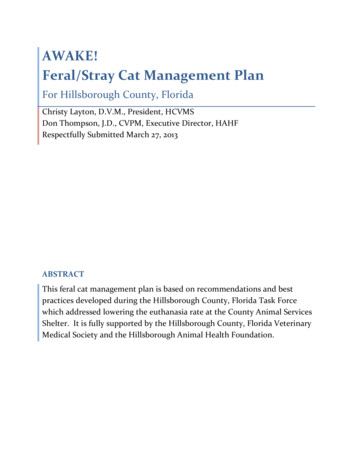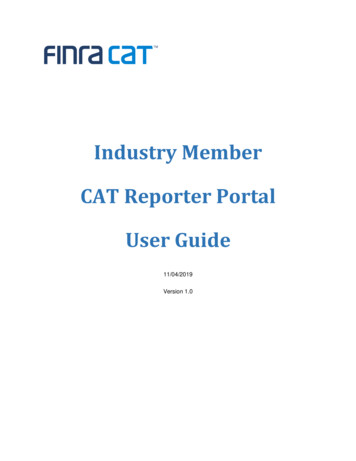
Transcription
dtheHillsboroughAnimalHealthFoundation.
ExecutiveSummaryCat overpopulation issues in Hillsborough County are significant, and a response must beformulated which provides for the concerns of all stakeholders. Hillsborough County hasalways led the nation in animal control best practices, and the issue of cat overpopulationshould be no different. A Hillsborough County Public / Private partnership can lead thenation in demonstrating what true animal welfare constitutes; while concurrentlypreserving the primary functions of county animal control. Any feral cat program musthave as its singular purpose the reduction of the population of outdoor cats, and that is along term effort that will only be accomplished thru education and the changing of humanbehavior. This proposal is presented in response to the problem of feral and stray cats inHillsborough County.The mission is simply stated – to provide for the public health, which must remain theprimary focus of Animal Control. This is the fundamental reason the department exists.At the same time, the mission must include safe sanctuary to feral cats while educating thecommunity of the importance of responsible pet ownership. Currently, hundreds (andperhaps thousands) of people are providing care (to some extent) for feral and stray catsaround our county. Additionally, the county and other non-governmental organizations arespending substantial sums of monies providing free and low cost veterinary and otherservices to those caretakers. By pulling these pieces together, this partnership canefficiently provide care and shelter for a significant number of community cats that wouldotherwise be euthanized. The long-term solution is a change in human behavior; AWAKE!is the right method to change the human behavior while providing the short-term solutionswhich emphasizes a rational approach to cat management. We note the “sanctuary” aspectof the AWAKE! plan is a temporary part of the strategic educational plan to affect thosebehavioral changes.Most importantly, this program will be a model foranimal control that emphasizes the fundamentalrequirements of Responsible Pet Ownership: shelter,water, food, basic medical care, and a safe environmentthat protects both the animal and public health. It isimpossible to expect the community at large tounderstand the importance of Responsible PetOwnership if the county animal control response to cat overpopulation is to simply dumpthem outside. This is true regardless of whether the cat has been sterilized and vaccinatedor not. This partnership resolves that issue as the community will be able to see value inevery animal life and the importance placed on those lives by the animal loving communityof Hillsborough County. Together, this plan is possible!A sanctuary program is thepenultimate intersection ofresponsible pet ownershipand animal welfare.Essential to this plan is the AWAKE! strategy of TENVAC. This strategy, representing theprocess of Trap, Evaluate, Neuter (spay), Vaccinate, Adopt, & Contain, is designed to placeas many cats as possible into other programs and homes, while providing an alternative tothose animals unable to be adopted for whatever reason. It is expected a true publicprivate partnership can adopt and foster a substantial number of cats entering AnimalServices. According to data developed by no kill proponents there are far more peopleseeking pets that can be encouraged to adopt; and according to that same data there are farHillsborough Animal Health Foundation AWAKE! Cat Sanctuaries2
less animals being euthanized. Additionally, Animal Services data suggest 10-15% of catsentering the shelter will have to be euthanized for medical reasons. Assuming all of thisdata is correct, very few cats should require containment; and as such any sanctuaryoptions will be a ‘last resort’ primarily for animals that are difficult to adopt for otherreasons.To conclude, this plan is about Responsible Pet Ownership! We simply cannot expectHillsborough County residents to substantially change their perception of pets and petresponsibilities while we endorse a program in which cats are left behind dumpsters and oncity streets. There is no question cat advocates are correct when they state part of theproblem is cat owners who dump their owned cat out with managed colonies – but thatwon’t change as long as cat owners perceive the dumping to be ok. Thirty years ago,communities did not understand fecal contamination and consequently poop stations wereunheard of. Today, everyone knows to pick up pet droppings. We must change thecommunity mindset about the value of cats, or this problem will never be resolved. TheAWAKE! sanctuary program is the penultimate intersection of responsible pet ownershipand animal welfare, and will stand as testament to the importance of pet ownership andhumane animal care. It is the only solution that addresses the issues of all stakeholderswithout compromising the most important concerns of each party involved.NOTE: This report is not intended to be a fully developed business or operational plan.Should the task force and BOCC recommend proceeding with this proposal a fullydeveloped plan will need to be created. However, this report does represent thefundamental requirements of a well-managed feral cat program that follows best practices.Those “best practices” were fully discussed during the Animal Euthanasia Task Force thatjust concluded its deliberations for the County. All aspects of this plan were evaluated inconjunction with all task force recommendations; and has been carefully considered by asignificant number of veterinarians in the local community. Consequently, AWAKE! isfully endorsed by the local veterinary community of Hillsborough County, Florida.3Hillsborough Animal Health Foundation AWAKE! Cat Sanctuaries
OtherSimilarUndertakingsOverview of other facilitiesContrary to some who seem to believethe notion of cats indoors or containedoutdoors is pure fantasy, the reality ismany informed organizations andindividualsprovidecatsanctuaryfacilities around the country. While BestFriends in Utah is the best knownexample, there are many others that areeasily found by a search of the web.Additionally, tens of thousands of catowners are already doing back yard“sanctuaries”, more typically called “catios” in which individual property owners take theeasy steps required to ensure cats remain safe in their outdoor enclosures. A Google searchshows myriad options for creating safe, outdoor areas for cats to enjoy without forfeiting theprinciples of responsible pet ownership.As the photographs show, there aremany ways to provide outdoor access forcats without sacrificing the safety thatcontainmentoffers.Inurbanapartments, suburban back yards, andrural farmsteads pet owners areembracing the benefits of cat enclosuresand the basics are not complicated. Thisproposal represents nothing more thanan expansion of best practices currentlybeing utilized by cat owners and catcolony managers around the country. Conversations with representatives from the PurrfectFence Company (listed below) establish that thousands of fence kits have been sold andinstalled in the United States by Purrfect Fence Company; and they are one of severalfencing companies for cat containment.Thisprogram emphasizing cats indoors or containedcan be implemented throughout the countyutilizing the energy and enthusiasm exhibited bycolony caregivers around the county. Working inpartnership with the county, local veterinarians,and other NGO’s will allow thousands of cats tohave a home.Hillsborough Animal Health Foundation AWAKE! Cat Sanctuaries4
Links to some of the many sanctuaries in the tmlLinks to cat fencing readily available in the .com/5Hillsborough Animal Health Foundation AWAKE! Cat Sanctuaries
OperationalOverviewOrganizational structureThis opportunity is best approached by a public and private partnership utilizing everyavailable resource to minimize cost and maximize quality of care and scope of the sanctuarynetwork. We believe this program can be implemented using existing resources, donations,sponsorships, limited cash infusions, volunteers, and bare minimum paid staffing.Organizational structure could begin at the county level with an AS employee (hereaftercalled Sanctuary Director or SD) assigned to sanctuary operations (which would includenon-fenced managed colonies as described below) who would hold overall responsibility forthis program. In the alternative, a non-governmental organization (hereafter NGO) couldundertake the program with county support. Almost certainly the SD would need paidstaffing of one veterinarian and two full time veterinary technicians to fully implement thisplan. The balance of all labor would be provided by NGO’s and volunteer care-givers - thereal power in this plan turns on the recognition and utilization of so much that is alreadybeing done on behalf of feral cats.OperationsAWAKE! cat sanctuaries are designed to deal with Animal Services intake cats, andHillsborough County managed cat colonies only. These sanctuaries would not be availableto outside counties or agencies seeking space for feral or stray cats. For existing outdoor catcolonies unable to meet the managed cat colony standard described below, sanctuary spacewould be used to provide homes for those cats unable to be adopted or otherwise placed.Existing managed colonies would need to be evaluated on a per case basis by the SDconsistent with the standards below, and the emphasis would be placed on removingcolonies of feral and stray cats near schools, hospitals, human food sources, and nursinghomes. These high risk colonies, along with shelter intake cats, are what AWAKE! CatSanctuaries are designed to help.As cats enter the shelter, TENVAC (Trap, Evaluate, Neuter, Vaccinate, Adopt, Contain)would be applied to each cat. Part of the evaluation process would include testing for FeLKand FIV, and cats testing positive would be isolated from other cats and contained. Thedecision to euthanize or to treat and contain would be up to the veterinarian on staff basedon the quality of life for the individual cat and the available space in an adoption programand the sanctuaries. Feline Leukemia cats would most likely be euthanized initially due tothe difficulty in managing these cases long-term and the grave prognosis of most cases. Inthe absence of a “FIV positive program” the cats testing positive for FIV may also beeuthanized initially based on space available, along with any other cats in which theveterinarian determines it to be medically necessary. As the program becomes moresuccessful, we hope to be able to save more of these positive cats as space opens in thesanctuaries and adoption programs. Of course, all the cats in this program that are adoptedHillsborough Animal Health Foundation AWAKE! Cat Sanctuaries6
or placed in a sanctuary will also be sterilized, vaccinated for Rabies, FVRCP & FeLK, aswell as micro-chipped.To gain full support from all stakeholders including the veterinary community ofHillsborough County, it will be essential for cat sanctuary programs to run concurrent withefforts which support the long term reduction in the feral cat population. Those initiativeswould include an ordinance banning outdoor feeding of feral and stray cats, an ordinancerequiring micro-chipping of all pets, and a coordinated marketing campaign educating thecommunity about the need to treat cats the same as dogs (proper feces disposal,inside/contained/leashed, etc).There is NO consensus in the local veterinary community on what standard would need toexist if the county were to consider allowing managed, uncontained outdoor colonies of feraland stray cats. The simple reality of known science clashes too severely with public healthstandards, wildlife considerations, and the welfare of the feral cats. However, in thecontext of moving toward a future in which cats are valued as highly as our dogs andtreated the same, we offer the following considerations for existing colonies that haveregistered caregivers.These considerations are in no wayintended to be guidelines for future cat colonies – under this plannew colonies would NOT be allowed once registration of existingcolonies is complete. These limitations would be strictly enforcedThe singularand the colonies closely monitored for compliance.motivation of anyUncontained, managed care colony requirements include:managed feral catprogram must be1. All cats must test negative for FIV and Feline leukemia.to quickly and2. All cats must be sterilized.3. All cats must be vaccinated for Rabies as required by F.S.humanely reduce828.30, and be kept current as required by F.S. 828.30.4. All cats must be micro-chipped and registered to an owner orferal and strayrescue.cat populations.5. All cats must be treated annually for internal parasites thatpose a zoonotic risk to humans, domestic animals and wildlife.6. Feral cat colonies sanctioned by the County cannot bemaintained within 8000 feet of schools, human food sources(groceries, restaurants, etc), daycare centers or hospitals; nor maintained within 8000 feetof public parklands or environmentally sensitive areas.7. Thorough monitoring of managed colonies is absolutely vital. No new cats can beallowed to migrate into existing colonies, and colonies must be aggressively cared for toensure full compliance with all measures. Any kittens and newcomers shall be immediatelyremoved and adopted/fostered/contained.Consistent monitoring will allow progressevaluations and ensure the cats are in good condition and safe.8. All feeding must be completed while the caregiver is present, and then ALL foodremoved, along with all visible fecal matter and food remains.9. All managed colonies shall be appropriately licensed, new colony establishment isstrictly forbidden, and the managed colony program shall be phased out over a 5 yearperiod of time.10. All managed colonies shall have the permission of all adjacent land owners, and anyproperty owners within 1000 feet of the colony location.Hillsborough Animal Health Foundation AWAKE! Cat Sanctuaries7
CapitalrequirementsOverviewA large, multiple colony sanctuary would require the followingessential investments:Land – to be donated by the county (optimum would be two 2-5 acre tracts, one in the northpart of the county and one in south county). Electricity would likely not be required, butfresh water and easy access would be vital. While land would be donated, it is expectedthat well water would be required, at an estimated cost per well of 5,000. Access roadingis difficult to price as it will be contingent on distance and other existing roadways.However, a budget of 50,000 per facility should be assumed for single lane access.Buildings – shelters would be built by volunteers using materials donated and/orpurchased. Estimated “worst case” cost per shelter is 5K. As an example, the picture hereis a 12x8 garden shed available in kit form.The cost for this particular kit is 2599.95.This kit can be bought online and the link isfound here. Any type of shelter used wouldrequire modifications including an outdoorenclosure and fecal sand box areas, but this isan illustration of how readily shelters can beobtained.Plans and other sources areavailable online which offer countless buildingsolutions. There are many options; and for acharitable purpose such as feral cats, it isexpected that the costs will be substantiallylower for each shelter than the 5K estimate utilized in this proposal due to sponsorshipsand other donated materials and/or labor.Fencing – Fencing costs will vary basedon the acreage being contained. PurrfectFence has already committed to helpingwith costs, and will provide wholesalecosts for this project. Other optionsmight also be available to reduce the costfor fencing. However, a safe estimate forfencing a 2-5 acre compound would be 25,000 using 8’ chain link with PurrfectCat fencing along the top.8Hillsborough Animal Health Foundation AWAKE! Cat Sanctuaries
A Single Residence Sanctuary wouldrequire the following:Land – provided by homeownerBuilding – variable based on existing accommodations atresidence. Buildings as shown above could be utilizeddepending on space and other considerations.Fencing – variable based on whether existing fence ispresent. Making an existing fence cat resistant would varybased on length of fence, but for a typical size backyard would be less than 1,000 for thecat resistant portion of the fencing.Capital Requirements SummaryBased on estimates, a 2-5 acre compound with 30 outdoor shelters housing between 10-25cats each would cost 230,000. This number could be substantially reduced through the useof volunteers and wholesale costing, and with county donated land it is expected that thetrue cost of the sanctuary would be less than 200,000. At a max capacity of 750 cats, thisis a capital cost of 266/cat if no reduction in expenses can be achieved through free and lowcost supplies and labor.Using estimates which assume a fence is already present, a backyard sanctuary should costless than 2,000 for space that would accommodate between 3-10 cats. At a max capacity of10 cats, this is a capital cost of 200/cat again assuming no reduction in expense based onfree or low cost.It should be noted that capital requirementsSponsorships can help – imagineare also expected to outlast the life span ofthe “Raymond James Cat House”the cats first contained; thus as the sanctuaryor the “TECO Place” as anis used by new arrivals the per-cat capitalexample!expense will drop further.Additionally,sponsorships and other fundraising effortscan be utilized to offset costs. As an example,businesses can sponsor a cat house at the sanctuary and have the building named for theircompany. Good advertising for the company and good for the cats. With aggressivemarketing efforts, company sponsorships could potentially fund the entirety of the projectwith county costs limited to the donation of the land.Hillsborough Animal Health Foundation AWAKE! Cat Sanctuaries9
OperationalCostsOverviewIt is expected that some expense associated with full time employees will be required.While much of the necessary oversight and basic care management can be done by certifiedveterinary technicians, a veterinary doctor will beneeded to both oversee and provide medical care for thesanctuary cats. This employee cost, including benefits,is estimated at 120,000/year.Additionally, pestNOTE: All costs can becontrol will be an annual expense that must besubstantially mitigatedconsidered and is estimated to be less thanby using volunteer 10,000/year.resources, fundraising,and the efforts of NGO’s.Feeding, litter box sand, and basic ongoing medicalcare is expected to cost less than 200/year for each cat.Currently, care givers are feeding and providing carefor thousands of cats in the community, and it isexpected that this network of care givers would be active in providing volunteer hours, andfundraising, to help provide ongoing expenses for our community cats.Bottom line – to provide care for thousands of cats in backyard and larger county operatedsanctuaries will not be cheap, but Responsible Pet Ownership is not cheap. It is expectedthat the cost per cat in sanctuary space will be 200/year including all operational costs.However, volunteer efforts, private fundraising, and sponsorships are just some of the wayscosts for the sanctuary program might be offset. As already noted in respect to the sheltercapital expenses, sponsorship for operational costs can be sought. For example, pest controlcould be provided free or at reduced cost in return for marketing and signage for thebusiness showing that company as the “exclusive provider of services” to our feral cats.10Hillsborough Animal Health Foundation AWAKE! Cat Sanctuaries
ConclusionWe cannot claim to be concerned with animal welfare while dumping cats onto our streetsto fend mostly alone. We also cannot expect our residents to understand the need to beresponsible pet owners while the people responsible for enforcing pet ordinances areviolating those very same requirements for feral cats. By establishing the TENVAC processand working aggressively to adopt and foster cats, we can minimize the numbers of catsrequiring sanctuary space. At the same time, the sanctuary stands as clear evidence to thecommunity that cats matter and are valued, that cats do not belong outside uncontained,and that this community will not tolerate cats beingtreated inhumanely and being forced to live a life ofabandonment on the tside!It is vital that Hillsborough County avoid the option ofsimply re-abandoning cats as a policy for dealing withoverpopulation and the desire to avoid euthanasia. Inaddition to no evidence showing Trap-Neuter-Release(TNR) success in large land mass areas, the evidence isclear that feral cats pose public health and equently, creating sanctuary space and focusing onadoption and foster programs for cats is the only otheralternative.More importantly, it is essential tosuccessfully changing Hillsborough County residents’attitude on pets and pet abandonment. Nothing lesstakes into consideration all the issues which feral cats present.Together, we can do this!11Hillsborough Animal Health Foundation AWAKE! Cat Sanctuaries
Uncontained, managed care colony requirements include: 1. All cats must test negative for FIV and Feline leukemia. 2. All cats must be sterilized. 3. All cats must be vaccinated for Rabies as required by F.S. 828.30, and be kept current as required by F.S. 828.30. 4. All cats must be micro-chipped and registered to an owner or rescue. 5.











